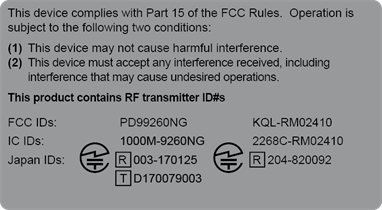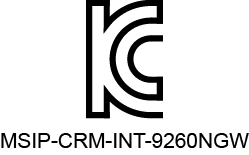Regulatory Information
|
1238888 |
The Vantage 's iADM outputs a single visible red laser, the source of which is a distributed feedback (DFB) laser with less than 390 milliwatt output. This Class I laser is harmless to your eye. You should avoid direct exposure to your eye at all times even though the human blink reaction to bright light provides a natural mechanism of protection to this visible laser beam.
This equipment is classified as a Class I laser product and meets the requirements of the Food and Drug Administration, Center for Devices and Radiological Health, Register 21 CPR parts 1000 and 1040, and those of the international standard IEC EN 60825-1 2007-03.
The Vantage is certified to comply with the protection requirements of the Council Directives 2014/30/EU (Electromagnetic Compatibility) and 2014/35/EU (Low Voltage Directive on Electrical Safety) and 1999/5/EC (R&TTE applies to radio equipment) as per requirements of the laws of the Member States.
USE OF CONTROLS OR ADJUSTMENTS OR PERFORMANCE OF PROCEDURES OTHER THAN THOSE SPECIFIED HEREIN MAY RESULT IN HAZARDOUS RADIATION EXPOSURE.
The user must adhere to work safety laws as stated in UVV BGV B2, January 1993.
Wireless Regulatory Information
Regulatory information for the Vantage ’s wireless components is listed on the rear of the Laser Tracker .

Figure 1-1 Wireless regulatory information label
“Contains FCC ID: PD99260NG, Industry Canada IC ID: 1000M-9260NG” displayed on the end product label.
The Vantage is incorporating the Intel wireless adapter, which is in compliance with local regulations. There are two Modules in this wireless adapter:
-
models operate using Modules 1 and 2.
-
models operate using Module 1.
Technical Information:
Module 1
| Certification Number | 1000M-9260NG |
| Model | 9260NGW |
| Antenna Type | Dipole Antenna |
| Antenna Gain | 2.2 dBi |
| Maximum Transmitter | Conducted Power: 21.15 dBm, 130.3167 mW |
| Maximum System EIRP | 23.35 dBm, 216.2719 mW |
| Exposure Conditions | 20 centimeters or greater |
Per RSS-102 Issue section 2.5.2, this device is exempt from routine RF exposure evaluation. The source-based, time-averaged maximum EIRP of the device is equal to or less than 1.31 x 10-2 ƒ0.6834 W (adjusted for tune-up tolerance), where ƒ is 2412 MHz;
1.31 x 10-2 24120.6834 W = 2.684 W EIRP
Module 2
| Certification Number | 2268C-RM02410 |
| Model | RM024 |
| Antenna Type | FlexPIFA |
| Antenna Gain | 2 dBi |
| Maximum Transmitter | Conducted Power: 8.00 dBm, 6.3096 mW |
| Maximum System EIRP | 10 dBm, 10.0000 mW |
| Exposure Conditions | 20 centimeters or greater |
Per RSS-102 Issue section 2.5.2, this device is exempt from routine RF exposure evaluation. The source-based, time-averaged maximum EIRP of the device is equal to or less than 1.31 x 10-2 ƒ0.6834 W (adjusted for tune-up tolerance), where ƒ is 2404 MHz;
1.31 x 10-2 24040.6834 W = 2.678 W EIRP
DECLARATION OF CONFORMITY
FCC Compliance Statement:
This device complies with Part 15 of the FCC rules. Operation is subject to the following two conditions:
-
This device may not cause harmful interference, and
-
this device must accept any interference received, including interference that may cause undesired operation.
Information To The User:
This equipment has been tested and found to comply with the limits for a Class A digital device, pursuant to part 15 of the FCC Rules. These limits are designed to provide reasonable protection against harmful interference when the equipment is operated in a commercial environment, this equipment generates, uses, and can radiate radio frequency energy and, if not installed and used in accordance with the instruction manual, may cause harmful interference to radio communications. Operation of this equipment is a residential area is likely to cause harmful interference in which case the user will be required to correct the interference at his own expense.
If this equipment does cause harmful interference to radio or television reception, which can be determined by turning the equipment off and on, the user is encouraged to try to correct the interference by one or more of the following measures:
-
Reorient or relocate the receiving antenna.
-
Increase the separation between the equipment and receiver.
-
Connect the equipment into an outlet on a circuit different from that to which the receiver is connected.
-
Consult the dealer or an experienced radio/television technician for help.
Any change or modification not expressly approved byFARO® Technologies, Inc. may void the user's authority to operate the equipment.
Due to the fact that the frequencies used by 802.11a, 802.11b, 802.11g, 802.11n, and 802.11ac wireless LAN devices may not yet be harmonized in all countries, 802.11a, 802.11b, 802.11g and 802.11n products are designed for use only in specific countries, and are not allowed to be operated in countries other than those of designated use. As a user of these products, you are responsible for ensuring that the products are used only in the countries for which they were intended and for verifying that they are configured with the correct selection of frequency and channel for the country of use. The device transmit power control (TPC) interface is part of the Intel® PROSet/Wireless WiFi Connection Utility Software. Operational restrictions for Equivalent Isotropic Radiated Power (EIRP) are provided by the system manufacturer. Any deviation from the permissible power and frequency settings for the country of use is an infringement of national law and may be punished as such.
FCC Radio Frequency Interference Requirements:
This wireless adapter is restricted to indoor use due to its operation in the 5.15 to 5.25 and 5.470 to 5.75GHz frequency ranges. FCC requires this wireless adapter to be used indoors for the frequency ranges 5.15 to 5.25GHz and 5.470 to 5.75GHz to reduce the potential for harmful interference to co-channel mobile satellite systems. No configuration controls are provided for Intel wireless adapters allowing any change in the frequency of operations outside the FCC grant of authorization for U.S. operation according to Part 15.407 of the FCC rules:
-
This wireless adapter is intended for OEM integrators only.
-
This wireless adapter cannot be co-located with any other transmitter unless approved by the FCC based upon MPE/Power Density/RF exposure transmitting assessment.
Industry Canada Statement:
This device complies with Industry Canada license-exempt RSS standard(s). Operation is subject to the following two conditions: (1) this device may not cause interference, and (2) this device must accept any interference, including interference that may cause undesired operation of the device.
EXPOSURE TO RADIO FREQUENCY RADIATION
The installer of this radio equipment must ensure that the antenna is located or pointed such that it does not emit RF field in excess of Health Canada limits for the general population: consult Safety Code 6, obtainable from Health Canada's website www.hc-sc.gc.ca/rpb
When using IEEE 802.11a wireless LAN, this product is restricted to indoor use due to its operation in the 5.15- to 5.25-GHz frequency range. Industry Canada requires this product to be used indoors for the frequency range of 5.15 GHz to 5.25 GHz to reduce the potential for harmful interference to co-channel mobile satellite systems. High power radar is allocated as the primary user of the 5.25- to 5.35-GHz and 5.65 to 5.85-GHz bands. These radar stations can cause interference with and/or damage to this device. The maximum allowed antenna gain for use with this device is 6dBi in order to comply with the E.I.R.P limit for the 5.25- to 5.35 and 5.725 to 5.85 GHz frequency range in point-to-point operation. To comply with RF exposure requirements all antennas should be located at a minimum distance of 20cm, or the minimum separation distance allowed by the module approval, from the body of all persons.
European Union:

The low band 5.15 -5.35 GHz is for indoor use only.
Japan:

5.15-5.35GHz indoor use only.

Indoor use only.
Singapore:

South Korea:


Taiwan:


For Wireless Regulatory Information in other countries, contact your Customer Service Representative by Phone, Fax or Technical Support.
